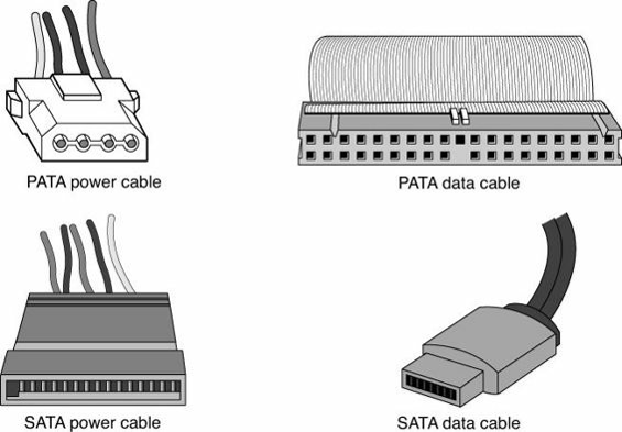Hardware Reference
In-Depth Information
As I noted at the start of this chapter, PATA is a 16-bit parallel interface that has been largely phased
out in favor of the serial interface of SATA. SATA's thinner and smaller cables provide higher
performance due to the higher cycling speeds allowed and are considerably easier to work with than
the wide PATA ribbon cables.
Figure 7.1
shows how the power and data cables SATA uses compare
in size to those PATA uses.
Figure 7.1. SATA data cables are much smaller than those used by PATA, whereas the power
cables are similar in size.
ATA Standards
Today, the ATA interface is controlled by an independent group of representatives from major PC,
drive, and component manufacturers. This group is called Technical Committee T13 (
www.t13.org
)
and is responsible for all standards relating to the Parallel and Serial ATA storage interfaces. T13 is
a part of the International Committee on Information Technology Standards (INCITS), which operates
under rules approved by the American National Standards Institute (ANSI), a governing body that sets
rules that control nonproprietary standards in the computer industry as well as many other industries.
A second group called the Serial ATA International Organization (
www.serialata.org
) was formed to
initially create the SATA standards, which are then passed on to the T13 Committee for refinement
and official publication under ANSI. The ATA-7 and ATA-8 standards incorporate both parallel and
serial interfaces.
The rules these committees operate under are designed to ensure that voluntary industry standards are
developed by the consensus of people and organizations in the affected industry. INCITS specifically
develops information processing system standards, whereas ANSI approves the process under which
these standards are developed and then publishes them. Because T13 is essentially a public
organization, all the working drafts, discussions, and meetings of T13 are open for all to see.
Copies of any of the published standards can be purchased from ANSI (
www.ansi.org
) or the IHS
Standards Store (formerly Global Engineering Documents,
http://global.ihs.com
)
. Draft versions of






